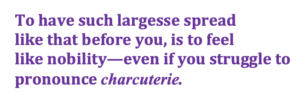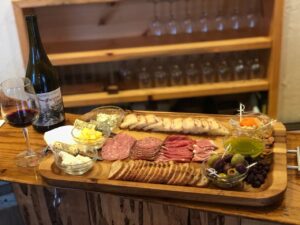
A good charcuterie is a work of art–a mosaic of color and of savory and sweet. It should make you pause a minute in admiration before digging in.
The first time I attempted say the word “charcuterie” out loud, I made a mess of it. My visiting friend from Portland gently corrected me, and I blushed because I thought the gaff betrayed a lack of urban sophistication. I have since realized that mispronouncing charcuterie is a common blunder—it’s a French word, after all. It also turns out that charcuterie is not just a city trend.
I am, in fact, surrounded by charcuterie plates here in the Applegate Valley. Since almost all of the wineries offer them, it is good to know how to pronounce the word correctly, and to know exactly what charcuterie is.
The word is French and is pronounced shaar-coo-tr-ee. I looked up the etymology of this mystical-sounding word and was disappointed. I’d been hoping for a profound—even spiritual— meaning that I could riff on. Maybe the word pertained to an ancient ritual, or maybe it had something to do with Greek mythology? To my great disappointment, the word charcuterie simply means ‘sliced meat.’
Oh well.
To be fair, ‘sliced meat’ is really under-describing what Charcuterie refers to. Although it comes from the practice of preserving meat in 15th century France, these days it implies quite a bit more. It is, in fact, “an embarrassment of riches”: crackers, meats, honeycomb, nuts, sauces, pâtés, dried and fresh fruit, pickled delights and various kinds of cheese. It’s essentially a showcase of the earth’s abundance. To have such largesse spread like that before you, is to feel like nobility—even if you struggle to pronounce charcuterie.
Is is not just the sheer amount of goodness, but the quality of each component that makes for a good charcuterie. Ideally, each item is carefully selected and carries a story of people and place: This cheese was made by the third generation dairy farmer next door; this mushroom was foraged from the hills behind our tasting room; this pear was picked from the historic orchard down the road.
Lastly, the arrangement is all-important, too. A good charcuterie is a work of art–a mosaic of color and of savory and sweet. It should make you pause a minute in admiration before digging in.
 When I asked around about good charcuterie plates here in the Applegate, Wooldridge Creek Winery came up again and again. While there are many good plates in the valley, I think Wooldridge comes up a lot because they makes their own cheese on-site. In fact, it was the first winery-creamery in Oregon. Aside from the cheese, every component of their plate is made in-house, or very nearby.
When I asked around about good charcuterie plates here in the Applegate, Wooldridge Creek Winery came up again and again. While there are many good plates in the valley, I think Wooldridge comes up a lot because they makes their own cheese on-site. In fact, it was the first winery-creamery in Oregon. Aside from the cheese, every component of their plate is made in-house, or very nearby.
Although the plate changes seasonally, here is what I found on mine:
Chorizo Salami
Soppressata –an Italian dry salami
Homemade mustard
Convino—an alpine style aged cheese soaked in red wine and lees
Pan de Higo (fig bread)
Noble Bloomy: a brie-style log wrapped in grape leaves and ash
Fromage Blanc
Kimchi fermented in house,
Spiced almonds
Handmade gluten-free crackers
The plate was an absolute work of art, too. Especially paired with their wines and consumed on their garden patio.
I have often wished for more dining options in the Applegate Valley, but I realize that a charcuterie plate, in all its showy abundance, could easily pass for dinner.
I plan on continuing my exploration of charcuteries of the Applegate Valley. Almost all of the wineries make a big effort to source from local producers. The plate at Walport Family Cellars is mentioned a lot. They feature local Rise Up! bread, Rogue Creamery Cheese, and fermented veggies from nearby Whistling Duck Farms. Equipped with my correct pronunciation, I think I’ll be going there next!

The charcuterie at Walport Family Cellars features Rise Up! bread, Rogue Creamery cheese, and fermented veggies from nearby Whistling Duck Farms.

